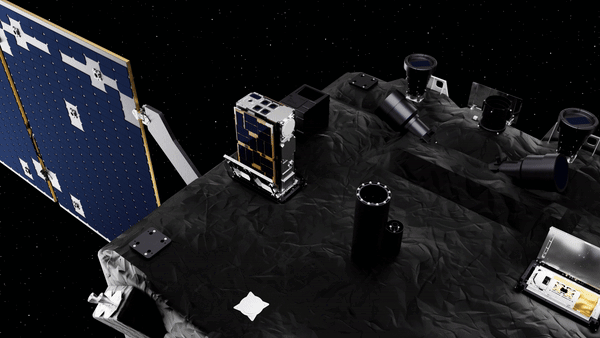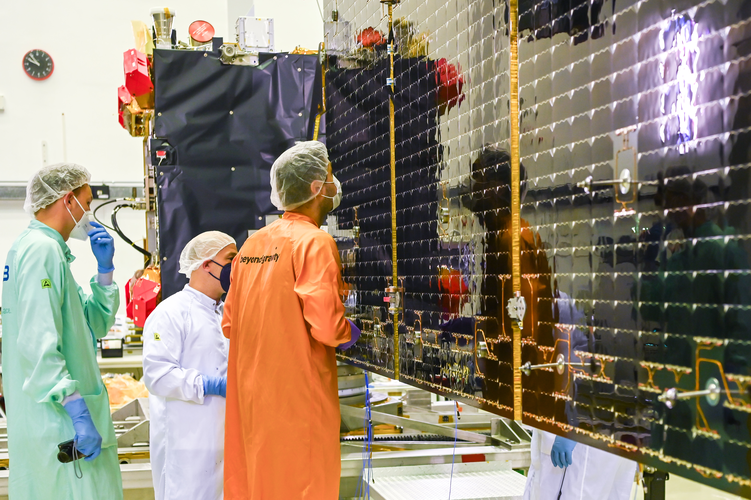Radar journey to centre of Hera’s asteroid with Juventas CubeSat
A small, shoebox-sized spacecraft delivered to ESA’s Hera mission this week promises to make a giant leap forward in planetary science. Once deployed from the Hera spacecraft at the Didymos binary asteroid system, the Juventas CubeSat will perform the first radar probe within an asteroid, peering deep into the heart of the Great-Pyramid-sized Dimorphos moonlet.

“Today’s asteroids are collisional fragments of the original building blocks of our entire Solar System, so being able to see how the interior of an asteroid is structured will give us valuable insights into the evolution of the Solar System, as well as planetary defence,” explains Michael Kueppers, ESA’s Hera project scientist. “Is this asteroid a solid monolith, or a rubble pile held together by its gravity? The answer has practical consequences for how incoming asteroids might be deflected away from Earth in the future.”
Measuring just 37x23x10 cm in size, the Juventas CubeSat has been overseen for ESA by Luxembourg’s GomSpace company with spacecraft integration taking place at GomSpace’s head office in Denmark. The company specialises in CubeSats – small, low-budget satellites assembled from standardised 10 cm boxes – though usually these are destined for Earth orbit.

Building for deep space
Jan Persson leads the Juventas project for GomSpace: “This is a very different mission compared to the usual CubeSats that we manufacture and fly. Going beyond Earth orbit and out into deep space is a rare opportunity, requiring extremely precise attention to detail. Juventas also needs a sufficiently agile navigation system to fly itself around an asteroid.”


Access the video
ESA’s Hera asteroid mission is Europe’s contribution to an international planetary defence experiment. Following the DART mission’s impact with the Dimorphos asteroid, a moon of the larger asteroid Didymos, in 2022 – modifying its orbit around Didymos and sending a plume of debris thousands of kilometres out into space – Hera will return to Dimorphos to perform a close-up survey of the crater left by DART. The mission will also measure Dimorphos’ mass and make-up, along with that of Didymos.
Hera is due for launch in October 2024, and aboard it will be two CubeSats for close-up observations of the asteroid pair: Juventas will be joined by the Milani hyperspectral mission. The trio will stay connected around the asteroids via an innovative inter-satellite link system.

Smallest radar to be flown in space
Named for the Roman name for the daughter of Hera, Juventas might be small, but it has a wide technical footprint. Its low-frequency radar instrument – the smallest radar system flown in space – was designed by France’s Institut de Planétologie et d'Astrophysique de Grenoble at the Université Grenoble Alpes and Technical University Dresden, with electronics coming from EmTroniX in Luxembourg and radar signal processing via a customised ‘field programmable gate array’ from FSatCom in the Czech Republic.
Its radar signals will be transmitted from a quartet of 1.5 m-long antennas, longer than the Juventas spacecraft itself, which have been contributed by Astronika in Poland.
“The Juventas Radar – or JuRa – instrument is unique, and will give the science community a rare insight into the making of an asteroid,” explains Jan Persson. “It has been highly miniaturised to fit into the CubeSat envelope. The main challenge has been that the instrument generates a lot of heat inside the spacecraft, which our thermal design team at GomSpace has worked hard to take care of.”

Hera system engineer Franco Perez Lissi adds: “To fly itself, Juventas also embarks a visible light camera, lidar, startrackers for navigation and a cold gas propulsion system, plus the inter-satellite radio link to share its position and data back with Hera.”
In order to perform its radar survey of the smaller asteroid, Juventas will go into a unique ‘Self-stabilised Terminator Orbit’ around Didymos. This involves orbiting in parallel with the asteroid’s day-night terminator line, balancing the weak gravitational pull of the asteroid with the faint but steady push of sunlight itself – solar radiation pressure. In fact, Didymos’s gravity is so low that Juventas will be orbiting at a rate of just centimetres per second, and JuRa will take advantage of that low speed to send the same coded signal down to the asteroid multiple times, boosting the instrument’s overall signal to noise ratio. The reflected signals will be decoded and converted into a 3D picture back on Earth.

Coming in for landing
Once Juventas completes its radar survey, it will switch into orbit around Dimorphos to begin the next phase of its mission: landing on the smaller asteroid. Jan Persson notes: “We’re still analysing the best way to do this, but our speed should be low enough – on the order of centimetres per second – that Juventas will come down without bouncing right the way up into space again. Onboard accelerometers and gyros will gather data from this moment to learn more about the surface properties. When Juventas finally comes to rest we want it to be in stable configuration to operate the spacecraft’s second science payload, the GRASS gravimeter.”
The first instrument to directly measure gravity on the surface of an asteroid, the Gravimeter for Small Solar System Objects, GRASS, has been developed by the Royal Observatory of Belgium (ROB) with Spain’s EMXYS company. The plan is for it to record how the gravity levels on Dimorphos change over the course of its orbit around Didymos.

Both the Juventas and Milani CubeSats have now joined their Hera mothership for testing at ESA’s ESTEC Test Centre in the Netherlands, the largest spacecraft test facility in Europe. The trio will be placed in the Maxwell electromagnetic compatibility chamber to check their inter-satellite links work as planned.


Access the video














 Germany
Germany
 Austria
Austria
 Belgium
Belgium
 Denmark
Denmark
 Spain
Spain
 Estonia
Estonia
 Finland
Finland
 France
France
 Greece
Greece
 Hungary
Hungary
 Ireland
Ireland
 Italy
Italy
 Luxembourg
Luxembourg
 Norway
Norway
 The Netherlands
The Netherlands
 Poland
Poland
 Portugal
Portugal
 Czechia
Czechia
 Romania
Romania
 United Kingdom
United Kingdom
 Slovenia
Slovenia
 Sweden
Sweden
 Switzerland
Switzerland













































